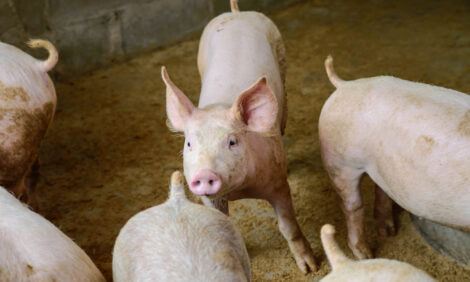



Trouw Nutrition Global Mycotoxin Review: 2020 Analysis and Outlook for 2021
Trouw Nutrition, Nutreco’s animal nutrition division, is sharing details of global mycotoxin analyses on feed ingredients and complete feeds in 2020 along with details of how Q4 2020 results might impact animal health and performance in 2021 and the company’s feed safety programme.Overall, the comparison of global results from 2020 with 2019 indicated a drop in the extent of contamination and concentrations of four of the main six mycotoxins examined – aflatoxins (AF), fumonisins (FUM), deoxynivalenol (DON), and zearalenone (ZEA). However, the average concentrations for T2/HT2 and ochratoxin A (OTA) increased in 2020, which could bring additional risk for some producers. The exclusive analysis on Q4 2020 maize data has already highlighted high risks for poultry producers, especially in India, Mexico, and South Africa. Data and analysis from the mycotoxin testing reports was presented during a webinar – Global Mycotoxin Review: 2020 analysis and outlook for 2021.
Mycotoxins: An overview
Mycotoxins are a secondary metabolite generated by some types of mould; some are produced in the field and others occur during storage. Mycotoxins can be found in grains, grain by-products, and protein sources like oilseeds (Figure 1). It is estimated that about 80% of agricultural commodities are contaminated.1
The type and number of mycotoxins found in feeds and feed ingredients vary regionally and annually, as multiple factors influence mould growth and mycotoxin occurrence.2 Elements that can alter mycotoxin levels include:
* Biological factors like crop susceptibility
* Environmental factors such as temperatures, humidity, and fungal load* Harvest practices
* Storage conditions including temperature, humidity, and aeration
* Transportation conditions and processing of commodities
Multiple mycotoxins can be present in the same feed or feed ingredient. They can interact in an additive and/or synergistic manner – potentially causing a larger response than expected. Mycotoxins in feed ingredients can hamper animal health and production and migrate into animal products like meat, milk, and eggs, potentially affecting humans, which supports the need for steps to ensure feed is safe. Trouw Nutrition’s mycotoxin risk management program runs thousands of rapid mycotoxin tests on ingredients and feeds to generate a global database, which not only helps in providing customized results for customers, but also assists the global audience on the trends of potential mycotoxin risk in the coming year for various animal species.
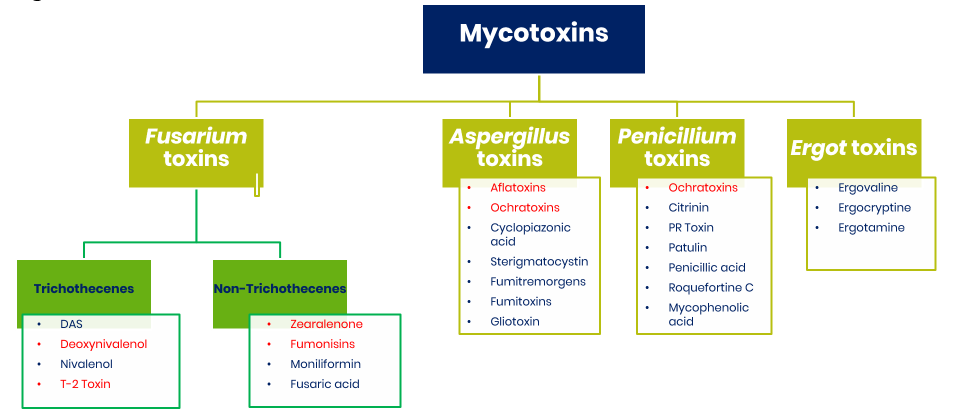
Differentiating Mycotoxin Contamination and Concentration is Crucial
When interpretating mycotoxin analysis results, it is important to distinguish between the extent to which samples are contaminated with mycotoxins (expressed as %) and the concentration of mycotoxins (ppb or ppm). Any values that are equal to and above LOD (limit of detection) will be considered for % mycotoxin contamination analysis. For the determination of average mycotoxin concentrations, however, any values that are equal to and above LOQ (limit of quantification) are considered. The % mycotoxin contamination indicates how many samples out of 100 are contaminated with mycotoxins, but doesn’t provide any information on how such samples can be toxic to animals. For example, 100% of the samples may be contaminated with a specific mycotoxin, but all samples can be safe to feed to animals. On the other hand, mycotoxin concentration indicates the amount of a specific mycotoxin found in one kg of a commodity and such measures can be used to assess at what concentrations of mycotoxins animals can be susceptible to mycotoxicosis.
Comparing mycotoxin levels in 2020 with 2019
Testing for mycotoxin levels in feeds and feed ingredients increased from 2019 to 2020, with 38,858 analyses being completed in 2020 across 35 countries. Many samples, about 51.6%, came from countries in Europe, followed by 18.4% from North America then South America, the Middle East and Africa, and Asia. The items tested included feeds, grains, grain by-products, protein sources, and silages. The percentage contamination dropped slightly between the years, with 88% of samples indicating at least one mycotoxin in 2019 and 84% being positive last year. The sample found with the highest concentration was a commodity from Brazil; it was found to have 32,400ppb of FUM.
In addition to testing multiple feed ingredients, feeds for different livestock species also were examined. Layer feed was most commonly tested, followed by feeds for broilers, sows, and piglets. The analyses also included ruminant concentrate, pet food, fish feed, and shrimp feed.
When 2019 and 2020 samples were compared by mycotoxin concentrations, results were lower for AF, FUM, DON, and ZEA in 2020, while 2020 samples had greater concentrations for T2/HT2 and OTA toxins. (Figure 2)
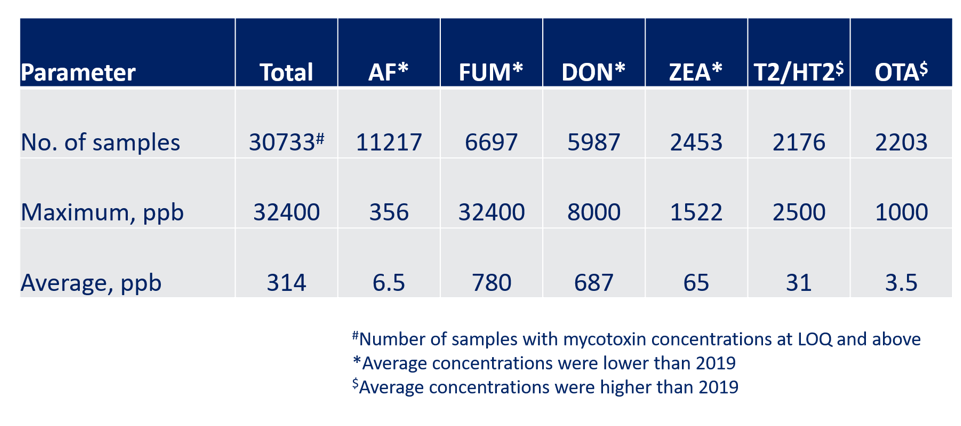
2020 analysis of raw materials
In the 2020 results, each grain examined had a varying percent contamination of different mycotoxins. The top 3 mycotoxins that were detected in barley were T2/HT2, OTA, and AF, while for sorghum those were OTA, FUM, and ZEA (Figure 3). Triticale was contaminated with a higher % for FUM and T2/TH2, while oats had most all the mycotoxins occurrences at 79% or above. As expected, FUM, AF, and DON occurred at higher % in corn, while wheat had all mycotoxins except ZEA between 70% and 78%. As anticipated, by-products tended to have higher concentrations of mycotoxin presence than the whole grain for a commodity.
Each protein ingredient also showed a range of mycotoxin contamination, with rapeseed meal having higher contamination for OTA, AF, and T-2/HT-2, while cottonseed meal indicated an increased percent of OTA, T2/HT2, and aflatoxin (Figure 4). Soybean meal and sunflower meal are the two most common protein-rich ingredients used worldwide in making animal feeds. Both ingredients had more than 90% contamination for OTA, T-2/HT-2, and ZEA, while FUM and AF were also at 90% or above contamination for sunflower meal. Peas, unexpectedly, contained all six mycotoxins at 100%.
It can be concluded on raw material analysis that although all grains, by-products, and protein sources were contaminated with all mycotoxins to a significant extent, the contribution of mycotoxin concentrations towards final feed is more from grains and grain by-products.
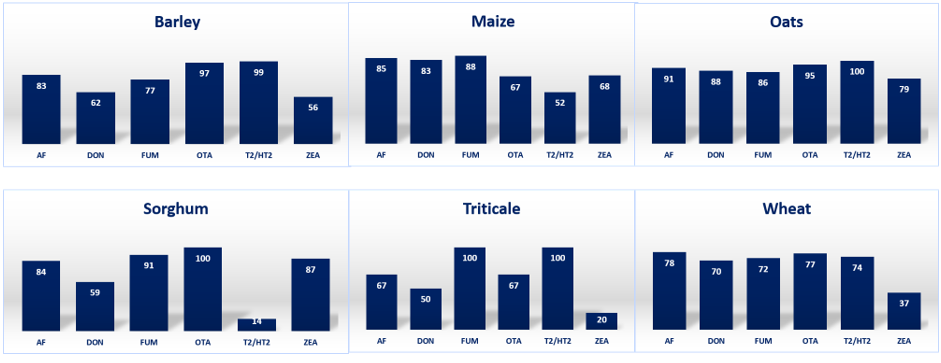
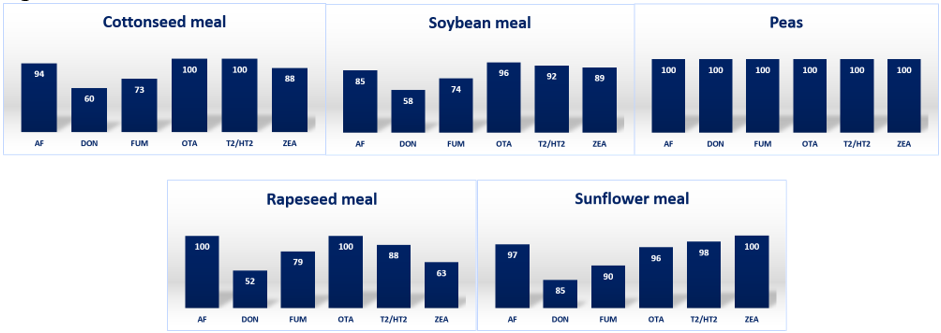
Mycotoxin Risk Analysis
Mycotoxins in feed can negatively affect livestock consuming the material, but not all mycotoxins influence animals in the same way or generate the same amount of risk to production. Interactions can be different based on the types and numbers of mycotoxins present, the animal species in question, the age and gender of the animals, and the duration of mycotoxin exposure. Poultry, for example, is more tolerant to FUM contamination than swine, while cattle or dairy cows can manage higher levels of OTA than other species of animals.
To obtain a clear picture of mycotoxin risk to animals, it is advisable to analyze multiple mycotoxins in animal complete feeds rather than ingredients. If complete feed analysis data is not available, all the ingredients that are part of the feed should be analyzed for multiple mycotoxins. By adding mycotoxin contribution of different ingredients towards the feed levels of mycotoxins, total risk can also be estimated. Apart from mycotoxin analysis in feed or raw materials, other factors, such as the history of raw material sourcing, farm manager’s feedback on animal symptoms, and veterinarian’s report on post-mortem findings should be considered.
Global Mycotoxin Risk Profile: 2020
A simple “Color Card” for 2020 mycotoxin risk for various species of animals is depicted in Figure 5. It should, however, be noted that the risk profile does not take into consideration the interactions that may happen among various mycotoxins. As a result, for example, if there are two or three “low toxicity yellow” color risks, then it may be considered as “medium toxicity orange” color risk. Overall, DON was toxic to most species of animals, followed by AF, T-2/HT-2, and ZEA.
When a similar concept was applied on various regions of the world (Figure 6), AF and DON risk was the highest in Asia and Middle East and Africa, while OTA and T-2/HT-2 risk was the highest in North America. Medium toxicity was seen in Asia for OTA and T-2/HT-2 and the same was observed for DON in South America and T-2/HT-2 in Middle East and Africa. The remaining “Color Card’’ either was “low toxicity yellow” or “safe zone green.”
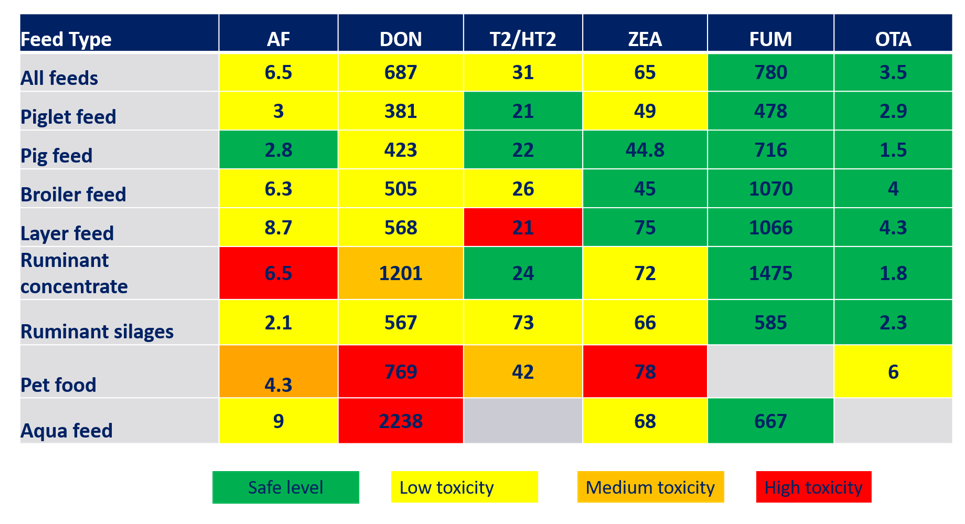
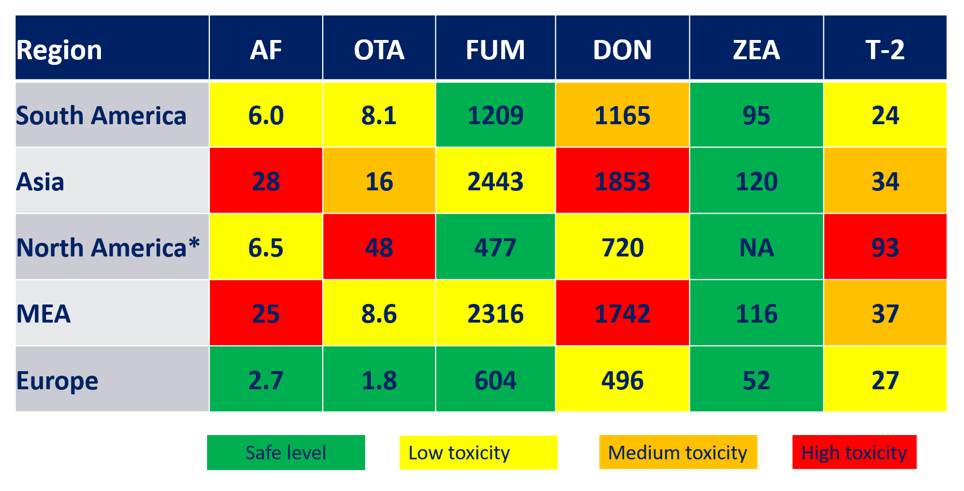
Initial look at 2021
Thus far into 2021, only a small number of feed ingredients have been analyzed. However, initial findings for corn harvested from September to December 2020 already highlight a few concerns for poultry producers. Early results show high toxicity levels from AF in corn in India, DON in both Mexico and South Africa, along with T2/HT2 in South Africa. ZEA and FUM levels appear to be low across multiple countries, however, aflatoxin may be an increasing concern in the U.S., Brazil, Mexico, and South Africa. Although some results are missing, Canada’s crop reports medium toxicity levels for DON and T2/HT2.
Conclusions
Mycotoxins continue to be a threat for animal production as reflected in more than 80% contamination of raw materials and complete feeds in 2020. Although there was a drop in the concentrations of four mycotoxins (AF, FUM, DON, and ZEA) in 2020 as compared to the results from 2019, OTA and T-2/HT-2 concentrations were higher, which can be quite challenging to monogastric animals. Early examination of corn to be used in 2021 feed production suggested the need for producers to continue to check for mycotoxin presence and be aware of where they source their feed ingredients.
Although there are steps producers can take to address and manage mycotoxins in ingredients, the process is involved and requires integration of multiple practices. A systematic response may include crop rotation, ploughing, fungicide use on crops, reviewing storage and handling, use of mold inhibitors, feeding binders and immunomodulators, overall farm management, and rapid testing.
“Mycotoxin risk management is an integrated process, and it starts with correct and timely understanding of the challenges in hand,” said Dr. Swamy Haladi, global programme manager for mycotoxin risk management with Trouw Nutrition. “Rapid analysis is key.”
Trouw Nutrition’s mycotoxin database shows the occurrence of mycotoxins in feeds and raw materials to provide additional interpretation regarding what the presence of toxins means for producers and their livestock, Dr. Haladi said during the presentation. “Having the right programme helps in minimizing the economic losses through all the sectors of animal production,” he added.
| References | ||||
|---|---|---|---|---|
| 1 Zhang et al, 2020. | ||||
| 2 Council for Agricultural Science and Technology, 2003. | ||||








